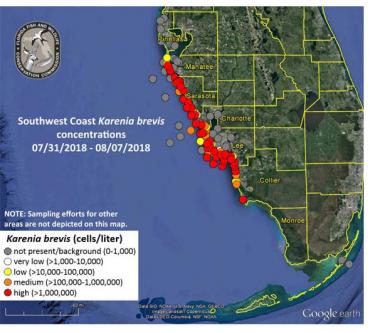
This year the red tide just won't go away.
Floridians along the west coast from Tampa to Naples are praying to God for the siege to end.
The naturally occurring microscopic alga commonly known as red tide (but more formally as Karenia brevis) has been documented along Florida’s Gulf Coast since the 1840’s. It occurs nearly every year. But this year its concentrations are higher and consequences more dire than most Gulf Coasters can ever remember.
And it's been going on since November.
"We just want answers," Bunny Elliott, a frustrated Englewood resident, told Sunshine State News Wednesday. "We need to know there's an end in sight and we're all willing to help. Just tell us how."
Red tide has turned southwest Florida beaches noxious and unusable, killed marine life, severely affected tourism-related businesses and created such health issues as difficulty breathing and burning skin.
Scientists are agreed about one thing: Blooms of Florida red tide typically begin 10-40 miles offshore, away from coastal sources of natural and human-contributed nutrients, then are transported inshore by winds and currents. I wrote about this in a SSN story in 2016.
“For various reasons, the conditions all come together that make red tide move from offshore to inshore,” said Quay Dortch, a program manager for the National Oceanic and Atmospheric Administration who studies harmful algal blooms. “Some years, it’s sort of a minor problem and some years -- like this year -- it’s a major problem.”
He said there's no telling how long this occurrence will last, but because we're now in the time of year the tide usually starts, it's probably going to be around a while longer.
 Dortch told USA Today research hasn’t yet found a definitive link between the severity of red tides and climate change, but scientists are looking. “Whether climate change will make these more frequent is something we just don’t know right now,” he said.
Dortch told USA Today research hasn’t yet found a definitive link between the severity of red tides and climate change, but scientists are looking. “Whether climate change will make these more frequent is something we just don’t know right now,” he said.
In fact, lots is happening this year -- not all of it bad. More study, more research, for example. According to an information sheet from Mote Marine Laboratory a Sarasota-based independent research institution that has studied Florida red tide for decades in cooperation with the Florida Fish and Wildlife Conservation Commission and numerous other partners, there's nothing simple about red tide. Lab data show "... K. brevis can use at least 12 sources of nitrogen and phosphorus nutrients, making bloom dynamics extremely complex and challenging to sort out."
But the chances of nutrients worsening red tide blooms when carried to sea from the Caloosahatchee River, or from any riverine flow are unlikely, says Mote. The estuary water has low salinity -- less salt than the Gulf -- and low salinity is not conducive to Karenia brevis red tide growth.
Still, Mote rules nothing out and calls it "an important topic that needs further research."
As it happens, Mote Marine Laboratory is in the right place at the right time now and with partner Florida Fish and Wildlife Conservation Commission (FWC), has accelerated its work to find the answers long-suffering residents are looking for.
From October 2017 through July 2018, Mote and its partners have monitored extensively for Florida red tide designed to augment public information on the status of the bloom.
"Communities affected by the current Florida red tide are asking great questions," Mote officials say, "in particular, what more can be done to address this challenging harmful algal bloom (HAB) and better protect public health and quality of life?"
On Friday a Web seminar -- a video chat -- from 3 p.m. to 4 p.m. will be open to the first 1,000 people who sign up. Mote scientists will attempt to answer pressing questions and talk about the multiple scientific studies moving forward this summer. The chat will be through the Zoom platform.
After the live Web chat, the video itself will be available on Mote's YouTube page: Click here.
Participants for the event are --
- Dr. Vince Lovko, staff scientist and program manager for phytoplankton ecology
- Dr. Tracy Fanara, staff scientist and program manager for environmental health
- Gretchen Lovewell, program manager for Mote’s Strandings Investigation Program
- Dr. Rich Pierce, senior scientist and program manager for ecotoxicology research
Click here for information on how you can take part in this red tide Web seminar.
Said Stacy Alexander, assistant vice president for community relations and communications for Mote, "There's also a critical need for much more science and technology investment to develop approaches for controlling and mitigating the impacts of red tides and other harmful algal blooms (HABs) when they do occur. Rapid environmental response methods and strategies that focus on reducing or eliminating the algae and/or their toxins, as well as restoring devastated fish stocks is urgently needed."
Reach Nancy Smith at nsmith@sunshinestatenews.com or at 228-282-2423. Twitter: @NancyLBSmith



Comments
Please tell me what I left